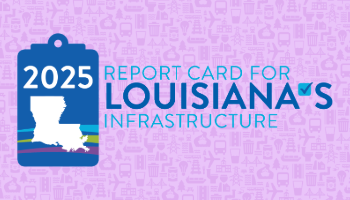If you’ve ever watched the news after a major storm hits the Gulf Coast, you know that Louisiana’s infrastructure faces significant external threats. These threats challenge and wear down an aging network of transportation and water systems.
ASCE’s Louisiana Section gave us the latest snapshot: Louisiana’s infrastructure earned a ‘C-’ on its 2025 Report Card. That’s a slight bump from the ‘D+’ the state received back in 2017, but still below the national average of ‘C.’
So, what does a ‘C-’ really mean? In short: Louisiana’s roads, bridges, water systems, and other critical networks are hanging in there, but they’re not keeping up with what is needed now or in the future. Aging assets, tight budgets, and increasingly severe weather events are putting serious strain on the system.
A few categories have improved since 2017:
- Aviation (C+)
Airports have seen upgrades that improve passenger experience and safety thanks to an uptick in federal funds from the COVID relief package and the Infrastructure Investment and Jobs Act (IIJA). These provided a combined $338 million to Louisiana airports. The Louisiana Aviation Trust Fund also adds $28 million per year.
- Coastal Areas (C-)
Louisiana has invested over $1.6 billion annually to combat coastal erosion, an upgrade from prior years, completing more than 150 restoration projects. These efforts protect wetlands that serve as natural storm buffers and safeguard oil and gas infrastructure. Still, millions of acres remain vulnerable, and future funding is uncertain after 2031.
- Drinking Water (D)
While still graded low, some systems have begun modernizing treatment processes and addressing contamination risks. However, the challenge of aging pipes—many installed before 1960 and older than their intended design lives—remains significant.
Other categories slipped or stayed stagnant:
- Bridges (D+)
Over 11% of Louisiana’s bridges are in poor condition, nearly double the national average. Deferred maintenance and limited funding have created a $9 billion gap for repairs and upgrades. This isn’t just an inconvenience; it’s a safety issue and one that threatens economic growth when commuters and freight movement have to seek alternative routes.
- Roads (D)
Louisiana faces a $24 billion maintenance backlog, and traffic congestion has surged by 13% since 2017. The state also ranks 14th in motor vehicle fatality rates per miles traveled. While the federal Infrastructure Investment and Jobs Act provided $5 billion for roads and bridges, that funding expires in 2026.
- Wastewater and Ports (D+)
Wastewater systems struggle with aging treatment plants and limited capacity, while ports—critical for Louisiana’s economy—need modernization to handle larger vessels and climate-related risks.
- Dams and Levees (C)
Only 4% of Louisiana’s 693 dams are in satisfactory condition, and maintenance performance has declined since 2017. Private dam owners are less likely to address deficiencies, which raises concerns about flood safety.
Why Does This Matter?
Louisiana has endured 36 extreme weather events in the past decade, causing $200 billion in damage. Infrastructure resilience isn’t just about convenience; it’s about protecting lives, property, and the economy. Without significant investment, these vulnerabilities will worsen.
What Needs to Happen?
ASCE’s recommendations boil down to five big moves:
- Increase Funding: Nearly every sector faces massive backlogs. Inflation compounds the problem, making delayed repairs even more expensive. Sustainable funding streams are critical to reverse decades of underinvestment.
- Better Data Systems: Decisions are only as good as the data behind them. Louisiana needs modern tools to monitor infrastructure conditions and share information across agencies. This would allow smarter prioritization of limited resources.
- Build Resilience: Hurricanes, flooding, and saltwater intrusion aren’t going away. Infrastructure projects must integrate climate risk assessments and adopt resilient materials and designs. Nature-based solutions, like wetland restoration, can also reduce future damage.
- Prioritize Safety: Aging roads, bridges, and dams pose real risks. Public outreach campaigns and proactive maintenance can help prevent accidents and protect communities.
- Collaborate More: Solving these challenges requires teamwork. State agencies, local governments, universities, and private industry need to share best practices and align investments for maximum impact.
Louisiana’s infrastructure is improving, but slowly. A ‘C-’ isn’t failing, but it’s far from excellent.
With more resources, smarter planning, and a focus on resilience, Louisiana can aim higher. After all, as ASCE Louisiana Section President Katherine Foreman Castille, P.E., put it: “Our communities have always come back stronger. Now, our infrastructure needs to do the same.”
